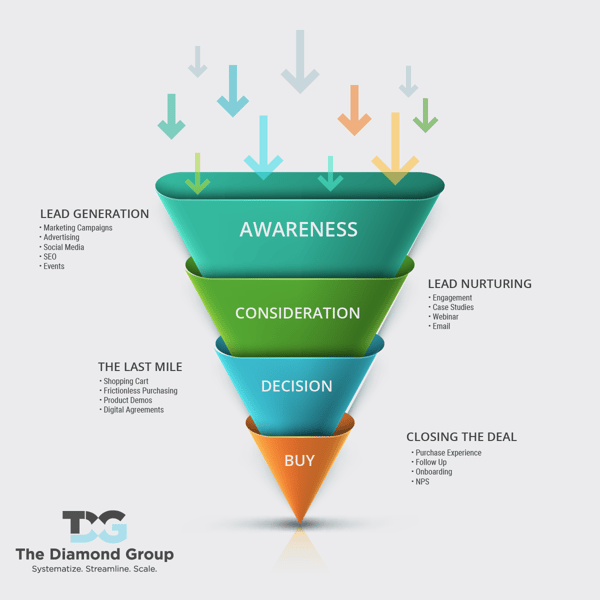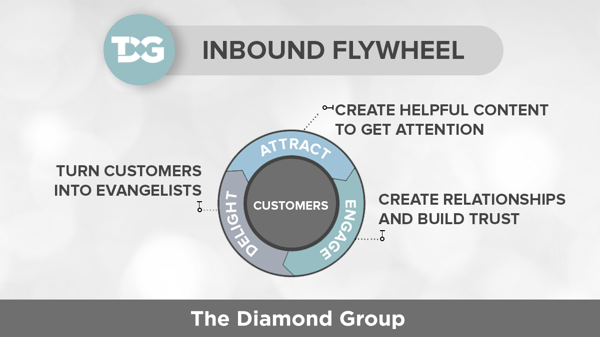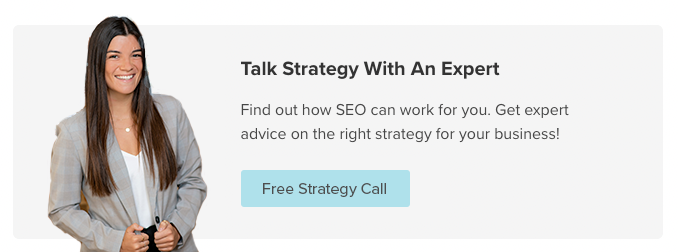The modern marketing funnel has been getting a lot of attention lately. Honestly, most of it has been negative. I've seen headlines like "The marketing funnel is dead." Ouch.
This is partly the marketing funnels fault. I mean no one really wanted ownership of it. Marketing and sales would fight over ownership with each one pointing a finger at each other, in a game of "not it".
The marketing funnel has also been fighting a relevance fight. It's been around a long time, but a lot has changed in that time. In healthcare, we talk a lot about how buyers have changed. But it's true in all industries. Consumers are in control and the marketing funnel hasn't fully met this new paradigm.
In this article, I'll talk about the marketing funnel and discuss recent changes in the funnel and it's considerable opportunities for marketers. I'll share strategies for all phases of the new marketing funnel, and piece it all together with section on strategy and content creation for a digital marketing buyers funnel.
First, let's dive into the classic marketing funnel as it existed for most of our lifetimes.
What is the traditional marketing funnel?
The marketing funnel is how we turn leads into customers viewed from a marketing perspective. The funnel has three layers, top, middle, and bottom. At the top of the funnel, marketers can cast a wide message and try to capture as many interested eyeballs as possible. Marketers, and sales teams can then nurture these leads and ideally turn them into customers. Each stage of the marketing funnel is smaller than the next, so it ends up looking like a funnel.
Why is each stage of the funnel smaller than the previous?
In a perfect world, everyone that visited your website and became a lead would also become a customer. We don't live in a perfect world. So leads fall out at different stages, thereby narrowing our funnel. It's a big part of marketing (and sales) job to turn as many leads into customers as they can. The better they get at it, the bigger the ROI on the marketing investment.
4 Stages of The Marketing Funnel
Let's take a look at the marketing funnel and it's four stages.

Awareness: This is commonly referred to as the top of the funnel or TOFU. This is the highest stage in the funnel and is the largest in volume. In this stage, the buyer realizes they have a problem.
Future customers will enter the top of your funnel through your marketing and advertising campaigns, and through referrals (word-of-mouth). Word-of-mouth marketing is quite possibly the most powerful force in the funnel, but we'll get to that later when I share with you the modern marketing funnel.
You can drive top of the funnel awareness by establishing trust and thought leadership through blogging, video, advertising, infographics, social media, SEO, etc. The list is long.
The awareness stage is where an unknown future buyer becomes a lead. Data is gathered on the buyer and is placed into a lead management system (CRM) like HubSpot. These leads in your CRM can now move to the next stage in the funnel, consideration.
In order to fully understand the Awareness stage for your buyer, ask yourself:
- How do buyers describe their goals or challenges?
- How do buyers educate themselves on these goals or challenges?
- What are the consequences of inaction by the buyer?
- Are there common misconceptions buyers have about addressing the goal or challenge?
- How do buyers decide whether the goal or challenge should be prioritized?
Consideration: In this stage, the buyer defines their problem and researches options to solve it. It's this stage where buyers become "marketing qualified" and are seen as prospects for your organization.
At this stage marketers will engage with prospects about their products and offerings. Email campaigns using marketing automation are commonly used. Using marketing automation, leads can be nurtured with case studies, content downloads, free trials and more.
To reach maximum success in this stage consider these questions:
- What categories of solutions do buyers investigate?
- How do buyers educate themselves on the various categories?
- How do buyers perceive the pros and cons of each category?
- How do buyers decide which category is right for them?
Decision: In this "last mile" stage of the funnel, buyers have already decided on the category of the solution they desire. They are now zeroing in on the best solution for their needs. Questions to consider asking in this stage:
- What criteria do buyers use to evaluate your offering?
- When buyers investigate your company offering, what do they like about it compared to others? What do they not like?
- Who is the decision maker? Is there more than one? Do their perspectives differ?
- Do buyers want to try before they buy?
Buy: A decision has been made and the buyer has reached the final stage. At this point the buying process is critical to getting the buyer through the funnel. Questions to consider in this stage:
- Is the buying process automated? Personalized?
- What is the overall purchase experience? Smooth and straight forward? Or clunky?
- Can buyers manage their account online?
- How likely will this buyer be to recommend your business to a friend?
The B2B Marketing Funnel vs. The B2C Marketing Funnel
Your buyer persona will ultimately determine their path through the funnel.
- B2C buyers will often go through the funnel alone or will pull in a trusted advisor. A B2C buyer may make it through the entire funnel without ever interacting directly with a company representative.
- B2B buyers will go through the funnel a bit differently. Their larger, more focused purchases will involve your sales team in the bottom stages of the marketing funnel.
The Circular Funnel - The Flywheel
For years companies have structured their business models around the funnel - and all was good. Recently, technology has played a big part in changing our culture and buying habits. Consumers are in control, and the funnel is no longer as relevant. Today, customer referrals and word-of-mouth have become the largest influence on the purchase process. The funnel sees these engines of growth as afterthoughts and not the driving force. Funnels produce customers, but they don't consider how those customers can help you grow. This is why the flywheel is getting so much love.

The flywheel model continuously stores and releases energy - which adds momentum to your business. The amount of energy the flywheel can store depends on how fast it spins, and the amount of friction the flywheel runs into. It operates similar to the wheels on a bike. The more energy put into the flywheel, the faster it spins and the faster your business can scale.
Digital Marketing Strategies for Attracting an Audience
For most of us this is top of the funnel strategy. In the flywheel, there is no top or bottom, but growing an audience is essential to creating energy. So how do we attract eyeballs with digital marketing? And how do we get those eyeballs to turn into customers?
Social Media:
Social media is a 100 pound gorilla for digital marketers. It's reach is virtually endless, and it's targeted advertising is coveted by advertisers everywhere.
We could do an entire series on the reasons to market your business on social media, but here are just a few highlights:
- 88% of adults are on social media
- Facebook accounts for 1 of every 6 minutes spent on Facebook
- An average YouTube session is 40+ minutes
The best part of marketing your business on social media is that it's (relatively) inexpensive and incredibly flexible. It's a great place to test messaging and concepts with little upfront cost. Add in the fact that you can be creative, and have some fun and it's easy to see why this is at the top of our list.
Display Advertising:
Google's display network reaches over 90% of adults and it's another great way to build your audience and attract attention.
Display ads are relatively inexpensive and can be sent out to thousands of websites for pennies per click. The net effect of all these impressions is that people will be able to see your ads over and over again. It takes dozens of times for you to see an ad before you really see it. In ad speak this is called "frequency". You can get a lot of frequency and retention with display ads.
Traditional Advertising:
While not technically a digital marketing strategy, traditional advertising will attract a lot of attention to your brand. It's more expensive than social media, or display ads but its reach (the number of unique eyeballs) can't be matched.
Pro Tip: When our clients have combined all three of these strategies at the same time, the results are off the charts!
Digital Marketing Strategies for Creating Customers
This is traditionally the middle of the funnel. In this stage buyers have decided they have a problem and are looking for a solution. When buyers find a match between their need and a service offering. During this stage it's crucial that buyers see you as an authority in your space.
Buyers are in control, and they use their computers to do the shopping long before they ever reach out to your business. Consider these statistics:
- 71% of consumers begin their shopping with a search engine
- 97% of consumers use the internet to find and research local companies, products, and services
- 92% of buyers read online reviews before purchasing a product
So we know that buyers are shopping online.
We know that they are looking at brands long before they ever connect with them in a way that a brand would recognize as a first touch.
To connect with a buyer in this stage of the marketing funnel, you'll need to work on several different strategies.
The best digital marketing strategies for middle of the funnel are:
- SEO
- Pay-per-click Ads
- Video
- Email Marketing
SEO: Search Engine Optimization
If you are not running paid advertising, SEO will most likely be the single largest source of traffic to your website. SEO will reach buyers in stage of the funnel. SEO is the only way to end up on page one in a search engine search. And 97% of buyers use the internet to research products and services.
So SEO is critically important if you want to be found online.
Almost no one clicks on anything after page one, so if you're not on page one you are not getting clicks.
A great way to target middle of the funnel buyers is answer every question you can think of that a buyer might ask. You can do this in the form of blogs, research papers, and featured content on your website. Be sure to optimize the content for mobile, because a high percentage of search at this stage is completed on mobile - even in the B2B space.
Reviews are another sweet spot when you're trying to create customers. Over 90% of buyers read them, and trust them as much as a recommendation from a friend or family member.
Reviews are important because consumers aren't as trusting of advertising as they once were. Where you once would have bought based on the fancy ad campaign, now you buy based on the ad campaign AND the reviews.
Digital Marketing Strategies for Closing Deals
It's at this stage that the buyer (finally) converts from a lead to a customer. Hooray!
So what is the best way to get a prospect to pull the trigger? Find ways to reduce the friction in the purchase process and you'll greatly speed up the buying decision.
Here are some ideas on how to reduce the friction:
Live Chat Service:
Install a live chat service on your website so prospects can instantly get answers to your questions. They can also book appointments and make a purchase.
Testimonials
Let your prospects know how happy your buyers have been after the purchase. Build up an arsenal of reviews and turn those into testimonials on your website. Create video testimonials to really drive up the engagement.
Free Trials
Create a free trial of your product or service so that a prospect can experience your offering first hand without making a deep commitment. Free trials can be short and limited. Prospects who commit to a free trial without a credit card attached convert about 1 in 5 times. Prospects who commit WITH a credit card convert 2 out of 3 times into a paying customer.
Get Your Flywheel Rotating
The flywheel is powerful but it won't start (or stop) rotating on its own. You'll need to apply force to get it spinning. And a lack of force will make it stop.
So how do you get your flywheel rotating?
The first step you can take is to connect with an internet marketing firm who understands the concept and has proven results. Would you be surprised if I said that was us? Even if it's not, I'm sure we could connect you with a friend or two that could get your flywheel spinning. We've made it easy to connect with us here.





